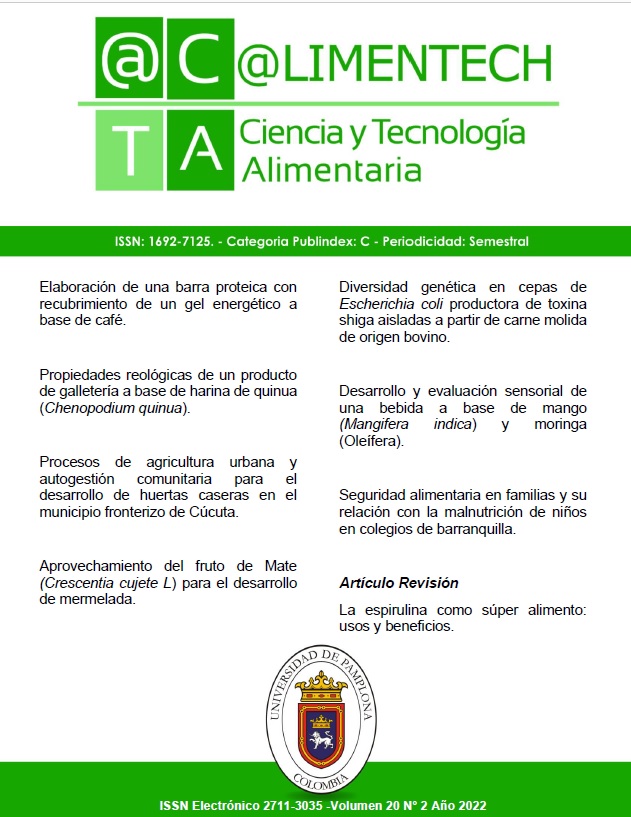Development and sensory evaluation of a nectar-type drink based on mango (mangifera indica)and moringa (oleífera)
DOI:
https://doi.org/10.24054/limentech.v20i2.2279Keywords:
acceptance, drinking, sensory evaluation, mango, moringaAbstract
Moringa is a herbaceous plant with high nutritional value, ideal for supplementing food, whose properties act as an antioxidant with functional characteristics. Therefore, the research objective was to develop a drink based on mango (mangifera indica) and moringa (oleifera) in order to establish the concentration of moringa with the highest sensory acceptability. For this, a selection of the mango variety with the best physical, chemical and colorimetric characteristics was made. Subsequently, mango drinks at 20, 30, 40 and 50% moringa were made and sensory evaluated using a 9-point hedonic test. It was found that the sweet mango variety presented better chemical qualities such as soluble solids, which enhances the sensory perception in the consumer, likewise that the concentrations of 40 and 50% of moronga were qualified as flavor invasive, while the concentrations 20 and 30% did not present differences between the sensory panel. Being the concentrations of 20 and 30% the most tasteful, acceptance by consumer judges. Being the most viable for the preparation of drinks based on sweet mango.
Downloads
References
Abd El-Razek, E., Abd El-Motty, E. Z., Orabi, S. A., & Abdalla, A. M. (2019). Improving fruit quality of mango fruits cv. Zebda by coating with moringa and green tea leaves extracts under cold storage. Middle East Journal of Agriculture Research.
Alberto Ortega Quintana, F., Salcedo Galván, E., Arrieta Rivero, R., & Torres Gallo, R. (2015). Efecto de la temperatura y concentración sobre las propiedades reológicas de la pulpa de mango variedad Tommy Atkins.
Alizadeh, A. (2021). Mango nectar as a substrate for Lactobacillus plantarum: Effect of stevia and inulin on probiotic viability and physico-chemical properties of the synbiotic product. Journal of Food Measurement and Characterization.
Cruz, S., Curbelo, C., & Reyes, J. (2022). Fortificación nutricional de la compota “upa-upa-upa” de mango-plátano-guayaba con moringa (Moringa oleifera).
Enrique, A., Chacín, C., Bonafine, O., Laverde, D., Rodríguez, R., Rafael, J., & Natera, M. (2009). Caracterización química y organoléptica de néctares a base de frutas de lechosa, mango, parchita y lima. Revista Científica UDO Agrícola, 9(1), 74–79.
Fajardo-Argoti, I. C., Jurado-Gamez, H., Alzate-Amariles, V., & Alzate-Amariles, V. (2021). Elaboración de néctar de mango con adición de probiótico Lactobacillus gasserie inulina como alimento funcional, sin aditivos químicos y como una alternativa a la industria de alimentos. Conocimiento Global, 6(S2), 1–23.
García-Paternina, M., Alvis-Bermudez, A., & García-Mogollon, C. A. (2015). Evaluación de los pretratamientos de deshidratación osmótica y microondas en la obtención de hojuelas de mango (Tommy Atkins). Información Tecnológica, 26(5), 63–70.
Gopalakrishnan, L., Doriya, K., & Kumar, D. S. (2016). Moringa oleifera: A review on nutritive importance and its medicinal application. In Food Science and Human Wellness.
Lakhanpal, P., & Vaidya, D. (2015). Development and evaluation of honey based mango nectar. Journal of Food Science and Technology.
Lebaka, V. R., Wee, Y. J., Ye, W., & Korivi, M. (2021). Nutritional composition and bioactive compounds in three different parts of mango fruit. International Journal of Environmental Research and Public Health, 18(2).
Ma, Z. F., Ahmad, J., Zhang, H., Khan, I., & Muhammad, S. (2020). Evaluation of phytochemical and medicinal properties of Moringa (Moringa oleifera) as a potential functional food. South African Journal of Botany.
Maldonado-Celis, M. E., Yahia, E. M., Bedoya, R., Landázuri, P., Loango, N., Aguillón, J., Restrepo, B., & Guerrero Ospina, J. C. (2019). Chemical composition of mango (Mangifera indica L.) fruit: Nutritional and phytochemical compounds. Frontiers in Plant Science, 10.
Moyo, B., Masika, P. J., Hugo, A., & Muchenje, V. (2011). Nutritional characterization of Moringa (Moringa oleifera Lam.) leaves. African Journal of Biotechnology.
Nkechinyere Onyekwere, N., & Felix I., N. (2014). Phytochemical, proximate and mineral composition of leaf extracts of Moringa oleifera Lam. from Nsukka, South-Eastern Nigeria. IOSR Journal of Pharmacy and Biological Sciences, 9(1), 99–103.
Okoruwa, M. I., Omoragbon, E., & Obiku, A. (2015). Effect of Moringa oleifera supplementation on acceptability and nutrient utilization of goats fed mango seed kernels.
Olson, M. E., & Fahey, J. W. (2011). Moringa oleifera: Un árbol multiusos para las zonas tropicales secas.
Peñaflorida, L., & Masbano, N. (2015). Acceptability of mango puree enriched with malunggay (Moringa oleifera, Linn) leaves extract. Asia Pacific Journal of Education, Arts and Sciences, 2(3).
Ramachandran, C., Peter, K. V., & Gopalakrishnan, P. K. (1980). Drumstick (Moringa oleifera): A multipurpose Indian vegetable. Economic Botany, 34(3), 276–283.
Saeed, M., Ali, S. W., & Ramzan, S. (2021). Physicochemical analysis of mango flavored yogurt supplemented with Moringa oleifera leaf powder. Journal of Food Science and Technology, 58(12), 4805–4814.
Sergent, E. (1999). El cultivo del mango (“Mangifera indica” L.): Botánica, manejo y comercialización.
Siller-Cepeda, J., Muy-Rangel, D., Báez-Sañudo, M., Araiza-Lizarde, E., & Ireta-Ojeda, A. (2009). Calidad poscosecha de cultivares de mango de maduración temprana, intermedia y tardía. Revista Fitotecnia Mexicana, 32(1), 45–52.
Soto, E., García, N., Vergara, R., Ettiene, G., Pérez, E., Sandoval, L., Bracho, B., San Rafael del Mojan, & Mara, municipio. (2015). Características físicas y químicas de frutos de mango (Mangifera indica L.), variedad Tommy Atkins, según madurez y sistemas de manejo, 32, 476–494.
Tatiana Carreño Diaz, L., & Lucía Nocua Mesa, O. (2011). Efecto combinado de dos recubrimientos comestibles con atmósfera modificada en mango (Mangifera indica) variedad Tommy Atkins mínimamente procesado refrigerado.
Vanajakshi, V., Vijayendra, S. V. N., Varadaraj, M. C., Venkateswaran, G., & Agrawal, R. (2015). Optimization of a probiotic beverage based on moringa leaves and beetroot. LWT - Food Science and Technology, 63(2), 1268–1273.
Yusuf, A. B., Turaki, A. A., & Adetunji, A. A. (2022). Formulation and evaluation of mango leaf tea supplemented with moringa and ginger powder. Haya Saudi Journal of Life Sciences, 7(5), 151–157.
Downloads
Published
How to Cite
Issue
Section
License
Copyright (c) 2022 @limentech, Ciencia y Tecnología Alimentaria

This work is licensed under a Creative Commons Attribution-NonCommercial 4.0 International License.








